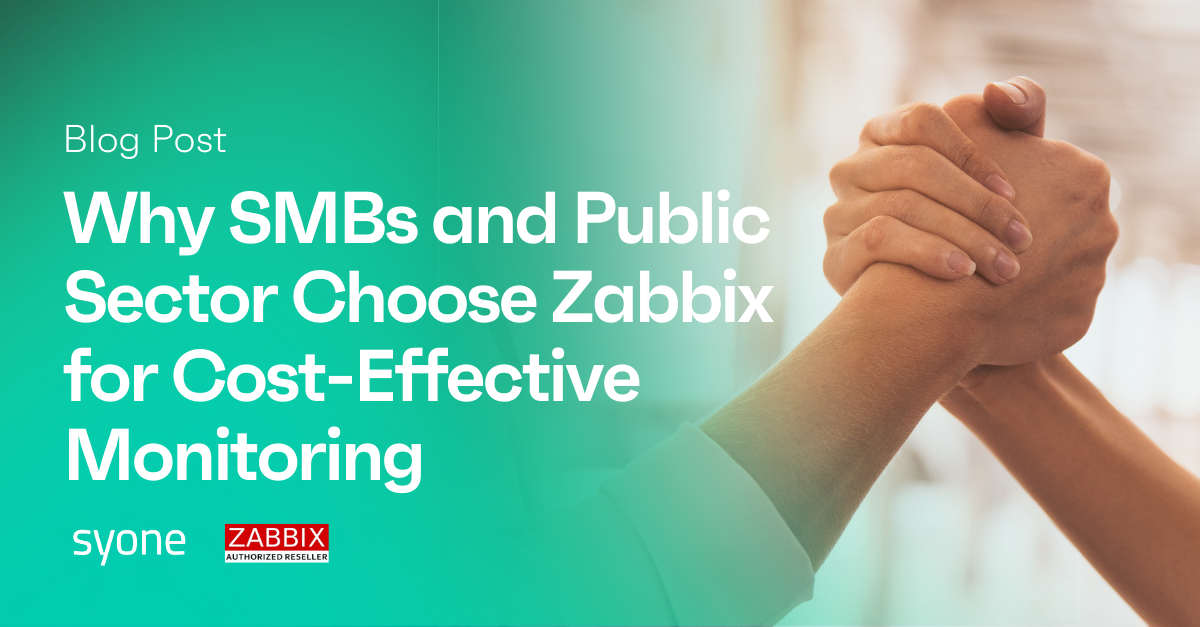Public sector organizations are under more pressure than ever to deliver reliable, secure, and efficient digital services. From municipalities managing utilities and transportation to government departments running critical citizen-facing systems, the need for robust IT monitoring is non-negotiable.
Yet, many of these organizations face significant budgetary constraints, legacy infrastructure, and complex regulatory requirements. They need solutions that are cost-effective, adaptable, and scalable, without compromising on visibility or control.
That’s where Zabbix, a powerful open-source monitoring platform, steps in.
With the ability to monitor thousands of endpoints, detect anomalies in real-time, and integrate with a wide range of systems, Zabbix is ideally suited to the public sector’s unique challenges. And when implemented by a trusted partner like Syone - Portugal’s only official Zabbix partner - public organizations benefit from 25 years of experience, deep technical expertise, and a proven track record in open-source transformation.
This article explores five real-world use cases for Zabbix in the public sector, demonstrating how municipalities and government agencies are leveraging open-source monitoring to improve service delivery, ensure uptime, and optimize resource allocation.
How Public Sector Organizations Benefit from Zabbix
Zabbix offers capabilities that align well with public sector IT priorities. It provides full-stack visibility, from physical infrastructure and network performance to application availability and user experience, all without licensing costs. Public organizations can implement it across departments and geographic locations without being penalized for scaling up.
Beyond affordability, Zabbix supports compliance and security objectives. With built-in encryption, role-based access, and data ownership controls, it gives agencies confidence in their monitoring setup. Real-time alerts, automated remediation, and predictive analytics help teams prevent outages and minimize service disruption.
Most importantly, Zabbix’s flexibility allows it to monitor both modern and legacy systems, a critical need in public environments where technology stacks often span decades.
As a certified open-source competence center, Syone has worked with numerous public organizations to design and implement Zabbix solutions that are tailored to local constraints, regulatory frameworks, and technical complexity.
1. Ensuring Uptime for Critical Citizen Services
Scenario: City Hall IT Infrastructure Monitoring
A mid-sized municipal government faces recurring service outages across its citizen service portals, internal administrative tools, and email systems. With limited IT staff and aging monitoring tools, the city struggles to detect issues before they escalate, causing public dissatisfaction and staff downtime.
Challenge
The IT department operates without real-time visibility into server health, application availability, and network performance. Their existing tools lack integration capabilities and produce too many false alarms, making alert fatigue a serious issue.
Zabbix Implementation
With Zabbix Partner support, like Syone, the city deploys Zabbix to unify infrastructure monitoring across departments. Using Zabbix’s discovery features and built-in templates, the team quickly begins collecting key metrics from servers, routers, databases, and service applications. Alerts were reconfigured based on root-cause correlation and severity levels, drastically reducing noise.
Outcome
The municipality achieves nearly 100% uptime across critical services. IT staff can address performance degradation before users are affected, and automated reports allow department heads to track system health without technical involvement.
The city reports improved citizen satisfaction and gains operational confidence, without increasing its monitoring budget.

2. Monitoring Distributed Systems Across Public Facilities
Scenario: Regional Government Network with Remote Offices
A regional public agency overseeing education, transport, and administrative services needs to monitor IT assets across dozens of geographically dispersed offices. With no central visibility, troubleshooting issues often involved manual checks, delayed interventions, and rising costs.
Challenge
Each office uses different systems and platforms. Legacy hardware, a mix of Linux and Windows servers, and poor documentation make it difficult to standardize monitoring. The central IT team needs a way to manage distributed environments from a single interface.
Zabbix Implementation
A Zabbix Partner, like Syone, is able to design a centralized Zabbix server supported by lightweight Zabbix proxies deployed at each regional office. This allows data to be collected locally and synced with the core system without taxing the central network. Custom dashboards and filtered views are created for different departments and user roles.
Outcome
The agency gains full visibility across all offices within a few months. Proactive alerts allow IT teams to respond before services are impacted, and centralized reporting helps leadership better allocate budgets and resources. Even facilities with limited connectivity benefit from local proxies that cache data during outages.
3. Securing Public Sector Networks from Threats
Scenario: Cybersecurity Oversight for a Municipal Utility
A city-owned water and energy utility provider faces increasing cybersecurity risks. With SCADA systems, IoT sensors, and billing platforms in place, the utility’s IT and OT environments are growing increasingly complex and vulnerable.
Challenge
Existing security monitoring is siloed and reactive. Network traffic anomalies, unauthorized access attempts, and suspicious system behavior often go unnoticed until after an incident occurs. Compliance audits revealed gaps in visibility and alerting.
Zabbix Implementation
Working closely with the utility’s cybersecurity team, a partner like Syone implements Zabbix as a real-time threat detection and visibility layer. The team uses Zabbix’s SNMP and agent-based monitoring to collect data from network devices, firewalls, and industrial controllers. Log monitoring, file change detection, and unauthorized login attempts are integrated into custom dashboards.
Outcome
Within the first quarter, the utility detects and responds to several access anomalies that would have gone unnoticed previously. They meet compliance requirements for system visibility and create escalation policies for high-risk alerts. By layering Zabbix into their security strategy, the utility achieves a proactive security posture without adding new security tools.
4. Improving Efficiency in Public Transportation Systems
Scenario: Monitoring Passenger Information and Vehicle Systems
A municipal transport authority operating buses and trams across a large metropolitan area needs real-time visibility into vehicle tracking systems, passenger information displays, and backend scheduling software.
Challenge
Frequent data synchronization issues cause delays in updating vehicle arrival times, frustrating passengers and affecting service quality. Existing monitoring tools don’t offer real-time insights into the health of mobile data terminals and Wi-Fi networks across the fleet.
Zabbix Implementation
A Zabbix Partner like Syone is able to help the authority deploy a hybrid Zabbix solution that combines on-premise servers with cloud data collection. Zabbix agents and SNMP are used to monitor IoT-enabled displays, GPS trackers, and backend application performance. The system alerts IT teams when data syncs fail or communication between buses and central servers breaks down.
Outcome
The transport authority reduces system downtime within the first few months. Public displays reflect accurate schedules, and maintenance teams are notified of data outages before passengers notice.
5. Supporting Smart City Infrastructure Initiatives
Scenario: Integrated Monitoring for Smart City Sensors and Applications
A local government launching a smart city program requires centralized monitoring of air quality sensors, smart lighting, traffic cameras, and public Wi-Fi zones. With multiple technology vendors and platforms involved, integrating these systems into a unified monitoring framework poses a major challenge.
Challenge
There was no single point of visibility. Each vendor has its own dashboard and alert system, creating data silos. The city needs to consolidate insights to manage performance, detect issues, and share data with stakeholders.
Zabbix Implementation
A Zabbix Partner, like Syone, develops a custom Zabbix implementation tailored to the smart city’s needs. Using Zabbix’s API capabilities and webhook integrations, data from third-party platforms is pulled into a unified dashboard. Real-time status views, historical trends, and predictive alerts are configured to support service continuity.
Outcome
The city gains the ability to monitor environmental sensors, connectivity levels, and energy consumption from a single interface. Departments can prioritize repairs and improvements based on real data, and the IT team has the tools to ensure system uptime across the board.
Zabbix becomes the foundation for smart city governance - scalable, adaptable, and vendor-agnostic.

Conclusion
The public sector operates in high-stakes environments, where system availability, data integrity, and cost control are paramount. Zabbix offers a compelling monitoring solution that meets these needs without the financial or operational trade-offs of commercial alternatives.
As demonstrated by the real-world Use Cases for Zabbix in the Public Sector, municipalities and government agencies worldwide are using Zabbix to enhance uptime, secure critical systems, modernize infrastructure, and deliver better citizen services.
When paired with the strategic expertise of Syone - Portugal’s leading open-source competence center and official Zabbix partner - public organizations can implement and scale Zabbix confidently, knowing they have the right guidance and support every step of the way.
Are you ready to modernize your public sector monitoring approach?
Talk to a Syone Zabbix expert today or Download our free guide on monitoring public infrastructure with Zabbix









